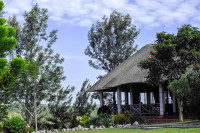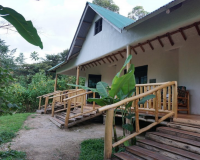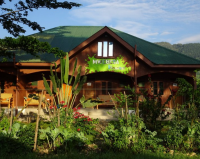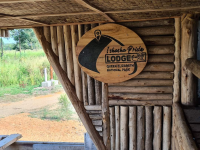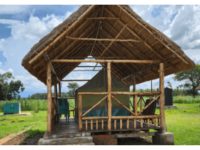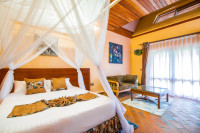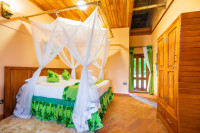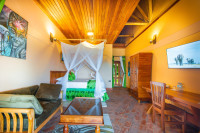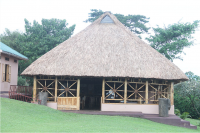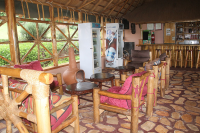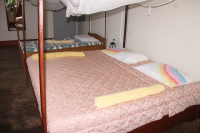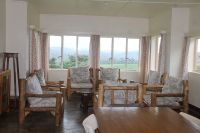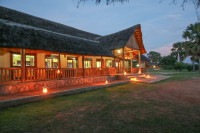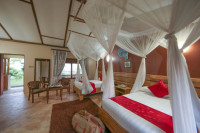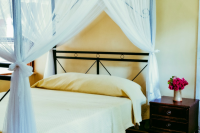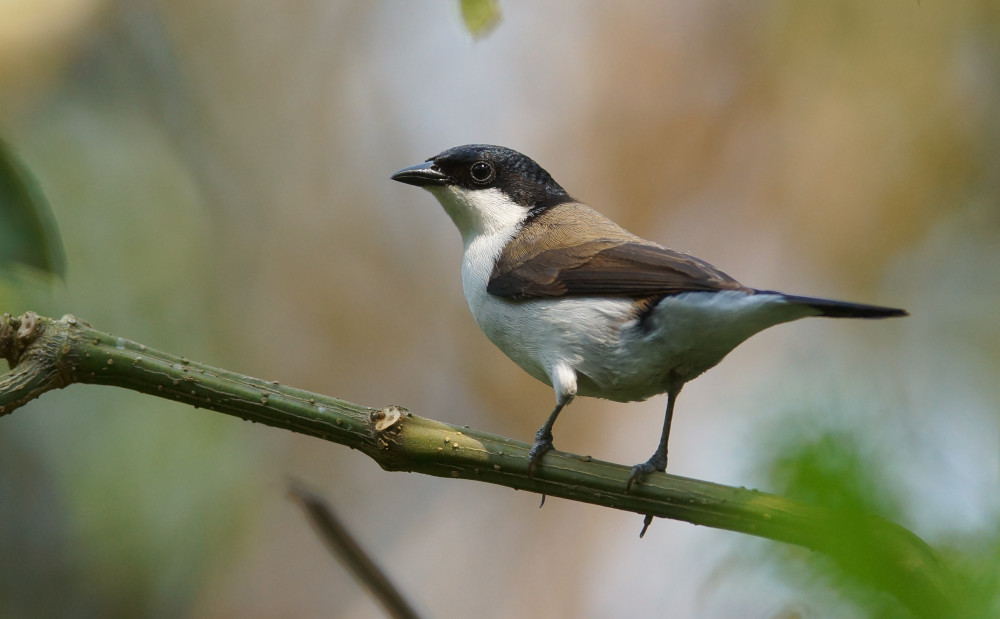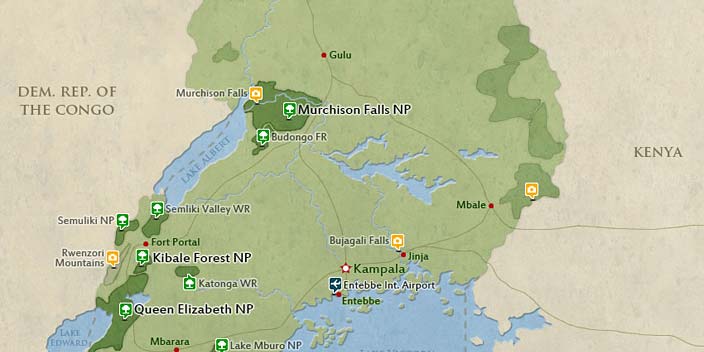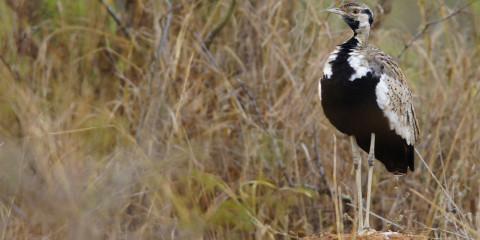
$3,135 pp (USD)
2 travelers on Start dateArrival
Arrival

Day 1
Bird Watching Tour to Mabamba Wetland for the Shoebill
Bird Watching Tour to Mabamba Wetland for the Shoebill
For those arriving early this morning, breakfast will be at Traveler’s Inn, Entebbe. Later, you'll drive to Mabamba Wetland for shoebills. Otherwise, the guide will pick you up from any spot, or hotel of your choice at 5:45 am.
The Mabamba Wetland system is along the shores of Lake Victoria, northwest of Entebbe. It is an important bird area in Uganda described and listed as a wetland of International Importance during the Ramsar COP9.
Found in a few marshes of East Africa, the shoebill is classified as vulnerable. Paddling through man-made channels and lagoons, traversing fishermen, several plants with beautiful flowers, papyrus reed beds, and birdlife is a rewarding experience. There are also other possible encounters besides the shoebill including the rare lesser jacana, blue-breasted bee-eater, malachite kingfisher, hamerkop, blue-headed coucal, winding cisticola, wyens weaver, papyrus gonolek.
You'll have a lunch break at the Equator and later continue to Lake Mburo.
- Main Destination:
- Mabamba Swamp
- Accommodation:
- Mpogo Safari Lodge
- Meals & Drinks:

Day 2
Bird Walk in the Morning, Boat Ride and Afternoon Game Drive
Bird Walk in the Morning, Boat Ride and Afternoon Game Drive
Most of the park is dominated by tall grass savannah dotted with acacia and euphorbia trees. Special birds in this habitat include green wood-hoopoe, white-headed and double-toothed barbets, Nubian, bearded and cardinal woodpeckers, trilling cisticola, white-winged black tit, chin-spot batis, greater blue-eared starling, Marico sunbird, black-headed gonolek, brown-backed scrub-robin, Rufous chested swallow, black-bellied bustard, African wattled plover, rufous naped and flapped lark, coqui francolin, yellow-throated longclaw, red-faced barbet, crested barbet, red-collared barbet, Tabora cisticola, bronze-winged courser, African finfoot, and white-backed night heron. Migratory brown-chested plovers can be seen from the second week of July to December.
This park also gives us a variety of wildlife viewing such as buffalos, impala, giraffes, warthogs, zebra, hippos, waterbuck, dwarf and banded mongooses, side-striped jackal, bushbucks, topi and on a lucky day you can see leopards.
- Main Destination:
- Lake Mburo National Park
- Accommodation:
- Mpogo Safari Lodge
- Meals & Drinks:

Day 3
Drive to Bwindi Impenetrable National Park- Buhoma Sector
Drive to Bwindi Impenetrable National Park- Buhoma Sector
The travel time from Lake Mburo to Bwindi is 6-7 hours. You will have a lunch stop in Kabale Town.
Bwindi has a unique rich and varied ecosystem and has lowland rainforest and Afromontane Forest. It's considered one of the most unique and important forests in Africa. UNESCO declared it a Natural World Heritage Site for Humanity for its many values and because it is vital to the survival of many endangered species.
You will have time to have a cool drink and enjoy the sights and sounds of the rainforest.
- Main Destination:
- Bwindi Impenetrable National Park (Gorillas)
- Accommodation:
- Ride 4 a Woman Guesthouse
- Meals & Drinks:

Day 4
Bird Watching or Gorilla Tracking in Bwindi Impenetrable National Park
Bird Watching or Gorilla Tracking in Bwindi Impenetrable National Park
Gorilla tracking in Bwindi is by far rated as the number one wilderness experience in the whole world. The gorilla excursion is another highlight of your safari!
Gorilla trekking is unpredictable. It's difficult to foresee how many hours you will hike. Expect to walk a long distance in steep and muddy conditions, sometimes with rain overhead, before you encounter any gorillas. A good physical condition is recommended. For conservation purposes, time spent with the gorillas is limited to one hour. A ranger will brief you on how to behave with the gorillas.
People who choose not to gorilla trekking go birding in the forest.
- Main Destination:
- Bwindi Impenetrable National Park (Gorillas)
- Accommodation:
- Ride 4 a Woman Guesthouse
- Meals & Drinks:

Day 5
Drive to Queen Elizabeth National Park - Ishasha Sector for Afternoon Bird Watching/Game Drive
Drive to Queen Elizabeth National Park - Ishasha Sector for Afternoon Bird Watching/Game Drive
You will explore Ishasha, considered by many as an off-the-beaten-track destination that you will surely enjoy.
River Ishasha alone is known for the high population density of the hippos. As you drive over the southern circuit plains of Ishasha in the open savannah, you will likely meet large herds of buffalos, elephants, Uganda kob, and topi, with occasional leopard sightings. The Northern circuit — an area near the main road is famous for tree-climbing lions. We look particularly at the many fig trees where lions like to stay. But you will also visit the Uganda Kob mating ground which is their preferred hunting area.
- Main Destination:
- Ishasha Sector (Queen Elizabeth NP)
- Accommodation:
- Ishasha Pride Lodge
- Meals & Drinks:

Day 6
Drive to Mweya in Queen Elizabeth National Park with a Brief Stop at a Fishing Village
Drive to Mweya in Queen Elizabeth National Park with a Brief Stop at a Fishing Village
Lunch will be at Mweya Peninsula.
The launch trip is the most popular activity at Mweya. Kazinga Channel is a natural narrow neck of water body connecting Lakes Edward and George; measuring up to 40km long, and is the most luxurious in the region; Plying these waters with comfort, elegance, and attentive service, affording superb wildlife viewing from your observation deck, is far much re-assuring! Along the Kazinga Channel, there are chances of spotting the African skimmers, snowy-capped robin, African spoonbill, kittliz plover, flamingos, great white and pick-backed pelicans, great and long-tailed cormorants, common squacco heron, African open-billed stork, white-faced whistling, knob-billed ducks and African fish eagle, crowned lapwing and many other shorebirds both migratory and resident. Giant Nile crocodiles basking in the sun, elephants thronging the banks, schools of hippos bathing in shallow waters, and giant forest hogs, are rarely missed.
- Main Destination:
- Mweya Penisula (Queen Elizabeth NP)
- Accommodation:
- Warujojo Safari Lodge
- Meals & Drinks:
Day 7
Morning Game Drive in Kasenyi Tracks in the Park/Afternoon Optional Visit to Katwe Salt Lakes
Morning Game Drive in Kasenyi Tracks in the Park/Afternoon Optional Visit to Katwe Salt Lakes
The best time for wildlife viewing is early in the morning! You will do that along the Kasenyi plains driving through several tracks famous for mating grounds for the lions, the Uganda Kob lekking grounds, etc. The main targets here are the lion and leopard. After the game drive, you will break at a viewpoint of Kasenyi Salt Lake. In the afternoon, you may visit Lake Katwe to have a feel of rudimentary ways of mining and extracting salt. Close by this lake is the famous Munyanyange explosion crater that is famous for flamingos plus many migratory waterfowls.
- Main Destination:
- Kasenyi Plains (Queen Elizabeth NP)
- Accommodation:
- Warujojo Safari Lodge
- Meals & Drinks:

Day 8
Drive to Kibale National Park; Lunch in Fort Portal, Afternoon Nature Walk in Bigodi Wetland
Drive to Kibale National Park; Lunch in Fort Portal, Afternoon Nature Walk in Bigodi Wetland
Bigodi Wetland Sanctuary is a community-owned and managed nature reserve. The habitat here consists of a swamp surrounded by low, scrubby secondary forest and cultivation. It is the best place to see over 6 different species of monkeys and primates. Key bird species include among others; white-spotted flufftail, green-backed twinspot, Cabanis's and joyful greenbul, scaly-breasted illadopsis, olive-green camaroptera, white-collared olive back, white-winged warbler, white-chinned prinia, black-bellied seed cracker, purple-banded sunbird, blue-shouldered robin chat, lesser honeyguide, Uganda spotted and speckle-breasted woodpeckers, white-tailed ant-thrush, red-capped robin chat, rufous flycatcher-thrush, great sparrow-hawk, red-headed bluebill, and luhdher's bush shrike.
On your tour, you will likely see several kinds of monkeys including black and white colobus, red colobus, blue monkey, grey-cheeked mangabey, red-tailed, vervet, L’Hoest, etc.
- Main Destination:
- Bigodi Wetland Sanctuary (Kibale NP)
- Accommodation:
- Chimpanzee Forest Lodge
- Meals & Drinks:

Day 9
Morning Tracking for Green-breasted Pitta and Afternoon Optional Chimpanzee Tracking in the Forest
Morning Tracking for Green-breasted Pitta and Afternoon Optional Chimpanzee Tracking in the Forest
The pitta normally displays just before the first light of the day. Other Kibale forest birds include among others; red-tailed and white-tailed ant-thrush, dusky-long-tailed cuckoo, Jameson’s and chestnut wattle-eyes, golden-crowned woodpecker, brown-eared woodpecker, shining blue kingfisher, slender-billed greenbul, African pied, and crowned hornbills, blue-breasted kingfisher, black-and-white shrike flycatcher, African shrike flycatcher, Narina trogon, toro olive greenbul, scaly-throated, thick-billed and lesser honeyguides, black bee-eater, yellow-potted, hairy-breasted barbets, Cassin’s grey flycatcher, bristle bill, red-capped robin chat, white-throated greenbul, African pitta (occasional), masked Apalis, red-chested owlet, scaly-breasted illadopsis, brown illadopsis, brown-chested Alethe, rufous flycatcher thrush, crowned eagle, etc.
After lunch, you will gather at the park headquarters for a briefing before the activity. Kibale is the best place in Africa to see chimpanzees.
- Main Destination:
- Kibale National Park (Chimps)
- Accommodation:
- Chimpanzee Forest Lodge
- Meals & Drinks:

Day 10
Drive to Murchison Falls National Park; Lunch Stop in Kagadi
Drive to Murchison Falls National Park; Lunch Stop in Kagadi
Murchison Falls National Park is Uganda's largest national conservation area. It is famous for its big game, spectacular scenery, and the falls for which the park was named. Abundant hippos, crocodiles, elephants, hartebeest, buffalos, giraffes, hartebeests, Uganda kobs, and waterbucks can be seen along with occasional lions, leopards, and Patas monkeys.
- Main Destination:
- Murchison Falls National Park
- Accommodation:
- Pakuba Safari Lodge
- Meals & Drinks:
Day 11
Early Morning Bird Watching /Game Drive, Boat Cruise Afternoon Visit to Top of the Falls
Early Morning Bird Watching /Game Drive, Boat Cruise Afternoon Visit to Top of the Falls
Birding here is a delightful experience. White-crested turaco, Heuglin's francolin, Abyssinian ground hornbill, blue-spotted and black-billed wood doves, vinaceous dove, black-billed barbet, Madagascar(occasional), little, blue-breasted, Northern carmine, red-throated and Sswallow-tailed bee-eaters, etc. are amongst a huge variety of African grassland species that can be seen here. The highlights for this day’s birding may be Stanley’s bustard, spotted thicknee, secretary bird — occasional, black-headed lapwing, white-browed sparrow-weaver, chestnut-crowned sparrow weaver, speckle-fronted weaver, etc.
You'll visit the northern sector of the park in the morning. In the afternoon, you'll have a boat cruise along the river Nile. After the bottom of the falls boat, you'll pay a visit to the top of Murchison Falls where the Nile narrows, squeezes, and plunges spectacularly over the escarpment with unfathomable might!
From here, you will drive to Masindi and stay at Masindi Hotel.
- Main Destination:
- Greater Murchison Falls Ecosystem
- Accommodation:
- Masindi Hotel
- Meals & Drinks:

Day 12
Drive to Entebbe for your Flight; Optional Visit to Zziwa Rhino Sanctuary
Drive to Entebbe for your Flight; Optional Visit to Zziwa Rhino Sanctuary
Today marks the end of the trip with an optional activity of visiting rhinos at Zziwa Rhino and Wildlife Ranch in Nakasongola.
- Main Destination:
- Entebbe (City)
- Accommodation:
- No accommodation (End of tour)
- Meals & Drinks:


